We knew we had to continue to create meaningful ties across teams as we made the evolution to Virtual First.
We knew this meant allowing for spontaneous connections, like chatting about weekend plans at the watercooler. But working primarily virtually means that conversations don’t always spark naturally—so we start experimenting a lot.
What we discovered is that you can recreate these watercooler moments by incorporating structured activities, like creative icebreakers, into your virtual meetings.
And it’s been working. About 88% of Dropboxers say they successfully work in Virtual First, and we’re seeing stronger team bonds.
Imaginative icebreakers aren’t just time-fillers. They’re a way to break down barriers and get people talking about both work-related challenges and personal interests.

What’s the “ice,” and why should you break it?
Before you go through your set agenda, is there a certain feeling in the air? Are any attempts at conversation met with flat smiles and one-word answers? Do you get the feeling that everyone is silently ticking down the seconds until the meeting finally starts?
That's the ice. And the thicker it is, the more awkwardness there is.
Often, the ice is chalked up as a symptom of needing to get to know each other better. And in many senses, that’s true.
There’s another layer that keeps the ice solid. It’s based on sociologist Erving Goffman's idea that interaction is like a performance—that we’re always aware of how others see us.
Over Zoom, we face the constant mirror of seeing ourselves on camera. We’re assessing our own performance—not just what we say, but our expressions, tone, and how we come across to others—making our interactions feel weird.
To help your team get to a place where being themselves feels safe, you need to warm that ice, meeting after meeting, until it melts away completely.
The best way to do this is to use icebreakers that encourage an equal distribution of conversational turn-taking and help your team open up without fear of judgment.

How icebreakers ensure every remote team member has a voice
At Dropbox, one of our key principles is making sure everyone stays on a level playing field. This belief shapes everything we do, and it’s the reason why we chose to go Virtual First instead of hybrid.
We want everyone to feel like they have a voice within our organization. If our employees feel safe and secure enough to show up as their truest selves, share their honest opinions, and laugh freely with the team, then we know we’re doing something right.
Our icebreakers play a big role in this.
Advantages of using inclusive icebreakers in a remote setting:
- Encourages active participation from all team members, not just managers or group leaders.
- Helps every team member feel like they’re an important part of the team and are valued for their unique contributions.
- Creates a safe space for employees to vocalize their opinions.
One trick we’ve used that helps turn up the atmosphere from freezing to warm is asking our team to complete a Working-With-Me template using Dropbox Paper.
.png)
It’s like a cheat sheet for employees to tell us about their personalities, work preferences, values, and unique traits.
We send the template to each employee and encourage them to be as honest as possible with their answers. We designed the worksheet to help us get to know each other's unique preferences and traits, as well as work-related details, like what activities energize them and which work hours they prefer.
.png)
With these insights, we can consider what we know about the attendees when selecting the best icebreaker for each meeting.
For example, because we know that our teammate appreciates open and honest communication, we understand that they might appreciate knowing what the icebreaker will be in advance of the meeting so they feel more prepared and comfortable, even if it’s just an icebreaker question.
Fun icebreaker questions to get employees in the mood to talk
Fresh, fun, and fantastic. Those are the three words we’d use to describe the perfect icebreaker question.
For instance, we might start our weekly meetings with a question from our check-in team-bonding ritual, like “What’s your internal weather right now (sunny, thunderstorm, cloudy, drizzle)?” Or we might go in with something a bit more left-field, like "What’s the first thing you’d do if you woke up as a robot?”
The trick is to ask questions that make your team stop and think and look forward to hearing their teammates' responses rather than zoning out while scrolling through their Slack.
Here’s a list of some of our favorite icebreaker questions.
Checking in icebreaker questions for your weekly team meetings
- In one word or one color: How are you feeling?
- If your mood right now were an animal, what would it be? Why?
- What’s your go-to strategy for dealing with stress?
- What song best describes your mood today, and what is the specific lyric that resonates with you the most right now?
- If you had to write a snappy headline about how you felt at the beginning of this meeting, what would it be?
Creative icebreaker questions to get your team thinking outside the box
- If you could only eat one color of food for the rest of your life, what color would it be? Why?
- What would be the best buy one, get one free sale of all time?
- What’s one thing humans rely on now that you don’t think will be around in the future?
- If you had to swap lives with any historical figure for a week, who would you choose, and what would you do?
- Would you rather be able to talk to all animal species (both land and sea) or breathe underwater?
Fun icebreakers to help you connect on a personal level
- What is the first thing you’d do if you woke up and discovered you were invisible?
- Would you rather be able to jump through time or teleport to any destination in the world? Why?
- If you had to decide between zombies or vampires taking over the world, which would it be? Why?
- If you could ask your future self one thing, what would it be?
- What does your ideal Friday night look like?
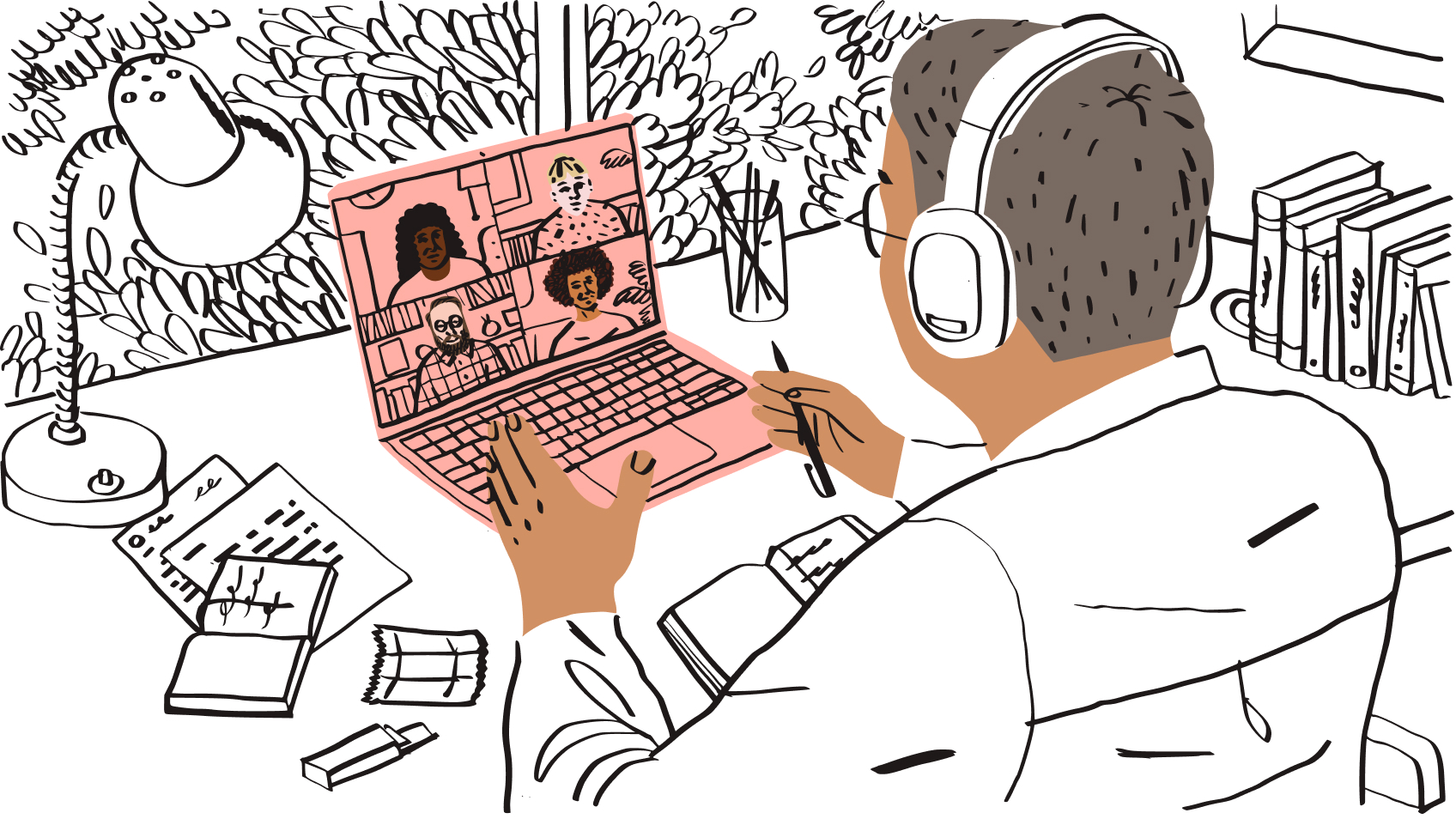
Simple questions for larger meetings
If you could be anywhere in the world right now, where you choose. Why?
If you had to replace your fingers with a household item, what would it be? Why?
If you were an actor/actress, would you rather play the role of a superhero or supervillain?
If it’s a hot, sunny day, would you rather sit inside in an air-conditioned room to do your work or be outside in the shade?
If you could create your ideal workstation, what would it look like, and where would it be?
Icebreaker questions for weekly team meetings
What’s the best piece of advice you’ve received from a coworker?
When was a time you asked for help that made a significant difference?
Can you share one instance during the week where something turned out better than you expected?
If you were to write a resume with only skills that are “useless” outside of work, what is one skill you’d add?
What was your dream job when you were a child? How does it compare to what you’re doing now?
So, for your next meeting, give this a shot: Choose one or two of the above icebreaker questions. Go around the virtual room or drop the question in your conference group chat before you start, and give everyone two minutes to share their answers.
Want something a little different? Instead of asking icebreaker questions, we sometimes play fun, engaging icebreaker games or activities.

Virtual icebreaker games and activities
There’s nothing worse than a quick icebreaker that turns into a marathon game of Monopoly.
You want to choose icebreaker games that fit neatly into the first five minutes of your meeting agenda without detracting from the meeting’s main purpose.
These are a few of our all-time favorites.
26. Go ahead and zen
Your team's brain doesn't suddenly stop ticking just because they’ve logged on for a meeting. They have to deal with thoughts of work they’ve done, work they still need to do, emails they’ve yet to check, messages they need to send, and Slack pinging in their background.
It’s draining.
So, help your team set aside a moment to be present for the meeting at hand by hosting a quick group meditation session. Encourage your team to let go of distractions, put their notifications on silent, and experience one minute of pure zen.
Start your meeting by taking your team through a simple box breathing exercise:
Inhale deeply through the nose for four seconds.
Hold your breath for four seconds.
Exhale for four seconds.
Hold your breath again for four seconds.
Repeat four times.
Or simply ask your team to take one long, deep breath in, and on the exhale, let go of their stress and arrive in the moment.
Some colleagues may feel uncomfortable sharing their zen time with the team, so make sure you give everyone the option to switch off their microphone and camera.
To make everyone feel more comfortable, we like to send our team a message in advance, over Slack or email, just to give them a heads-up on what to expect and how to prepare. If you want to do the same, you can copy and paste this template and use it for your next meeting:
“Hey team! For our next meeting, we’re going to be starting with a short, 60-second meditation as soon as we begin. Once everyone is on, we’ll start the meditation and then proceed with our agenda. If you don’t feel comfortable putting your mic or camera on, that’s perfectly fine! Just mute yourself and then dial back in when the 60 seconds is over (don’t worry, we’ll let you know when). Thank you all, we look forward to seeing you at [insert time].”
27. Non-essential essentials
Let’s be honest. All of us desk-dwellers have that one “non-essential” item in our workspace that we just can’t give up. They give us comfort and keep us sane. So have your team go around and share that one thing they can’t live without.
Ask them to show it on screen if they’re comfortable. For instance, it might be a cozy blanket, a mini snack fridge with different types of treats, or a coffee mug with their dog’s face on it.
See how many people share the same non-essential essentials, and encourage them to chat about why they think it’s a must-have.

Encourage your team to share and chat about their thoughts after the meeting in async chat, too. For example, two employees agreed that working with their dogs is a non-essential but essential part of their work environment.
After this discussion, one of them reached out to keep the conversation going. Not only did this help them bond over a shared interest, but it also made it easier for them to break the ice outside of formal meetings.
When we talked to psychologist and certified friend expert Dr. Marisa Franco on our Remotely Curious podcast about friendship, she explained that there are two ingredients that foster friendship: “continuous, unplanned interactions and shared vulnerability.”
Remotely Curious podcast: Friendship
So, using icebreaker games that turn into casual chats like these can really strengthen team connections and make the work environment more relaxed and collaborative. They can also pave the way to turning professional relationships into friendships.
28. It’s all in the cards
At Dropbox, we love creating connections through the power of stories and play. So we created what we believe is the best thing to happen to corporate games since, well, forever: The Corporate Tarot Connection Cards.

Here’s how it works. Just like in a Tarot reading, you get four cards:
- Energy Card: These cards focus on energy levels. For example, they might ask someone to reflect on moments when they were in a creative flow or used empathy to connect with their teammates.
- Emotion Card: These cards are designed to explore how someone feels about their work and related topics. For instance, they might predict feelings of being stuck or an obsession with control.
- Relationship Card: These cards include focused questions about an individual's relationship with their team and personal communication style. For example, a card might reveal a lack of communication and prompt discussion on how to address it.
- Journey Card: These cards delve into the individual's work journey, touching on various topics such as a loss in drive or growing motivation.
Additionally, there’s a wildcard that participants can use if they don’t want to answer a question or feel uncomfortable.
The aim of the game is to use the cards to gain insights into a person’s future based on the cards dealt. You start by laying out four situations like this:
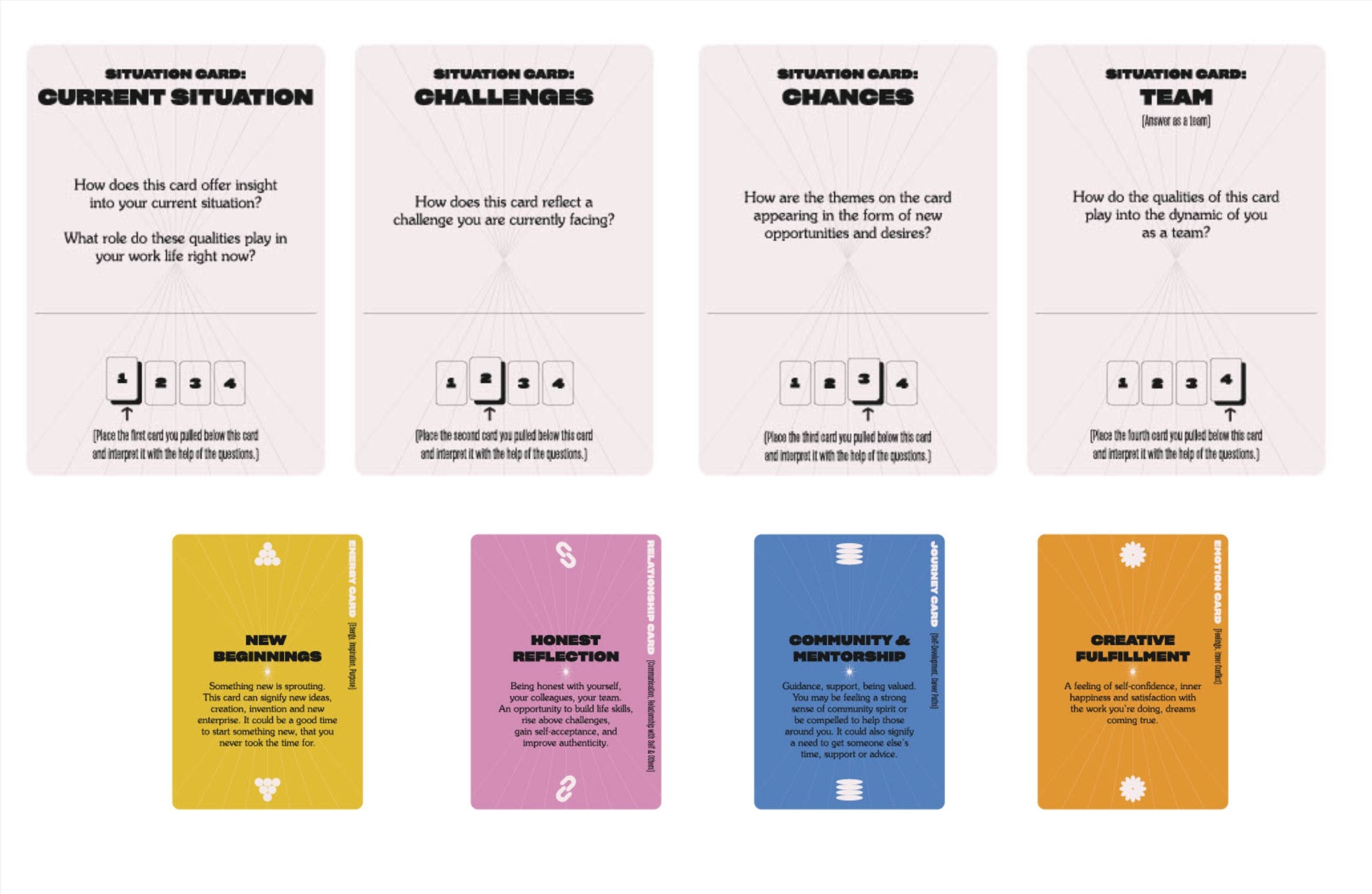
The person who has been working with your team the longest goes first. They choose four random cards and place each one under each situation card.
The first card describes your current situation, the second presents potential challenges, the third outlines work-related chances for development, and the last represents your team dynamics.
The person who drew the cards will then interpret what each card means in the context of their work situation. For example, if they draw a relationship card that says, “This card indicates you’re experiencing fear of missing out on something—more fun? A better job opportunity? A cool project? More money?” and they place it under the “current situation” category, they might reflect on how they’ve been feeling like they might be missing out on new opportunities by not exploring different roles or engaging in more exciting projects.
What we love about this game is that it relies on perspective—and perspective is everything.
It shapes how we feel about a situation and our role within an organization or group dynamic, and it can tell you a lot about your team and how they see themselves in your organization.
We’ve played this game in many meetings, but we recommend using it with two to four people, so it doesn’t get too long. Before you start, make sure everyone knows it’s a safe space. None of the stories, answers, or interpretations leave the group. Plus, nobody has to share anything they’re uncomfortable with.
29. Rapid fire
Spice up your meetings by playing a fun question-and-answer game we like to call Rapid Fire, where you set a one-minute timer and ask as many questions as possible.
We love rapid-fire questions because they remove the pressure that comes with trying to think up a perfect answer or question.
They’re all about quick conversations, raw honesty, and a hint of vulnerability in a safe space. Everyone's on an even playing field because no one knows what’s coming.
For smaller groups, we like to use our creative conversation starter cards as rapid-fire questions and have everyone take turns in the hot seat.
Before the meeting starts, we review the cards and list five to six tailored questions for each participant. For instance, last week, we used this method in a meeting with four employees.
If you have a small meeting coming up, feel free to use the questions as they are or customize them to fit your needs.
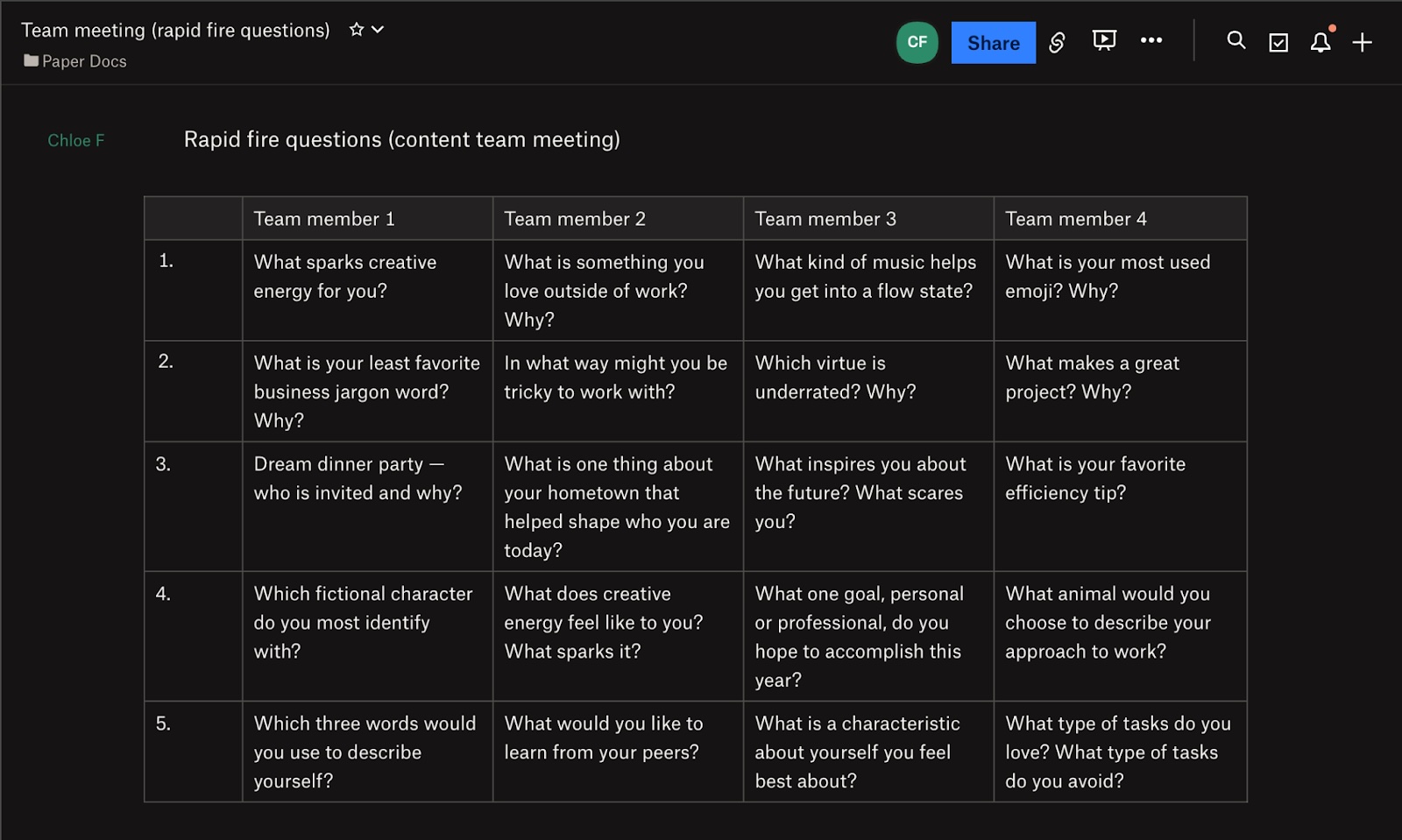

Then, explain to the group that you’ll show one card on the screen at a time. Have each participant write their answer on the paper in a designated section in under five seconds. Afterward, compare how many people got the same answer or discuss the variety of responses.
30. Good news all round
Start your meeting by asking each team member to share some good news from their week—no matter how small—and it doesn’t have to be work-related. Sharing these small wins helps to lift everyone’s spirits and bring the team closer.
We like to add a subheading to our meeting notes template and invite attendees to add their thoughts before the meeting starts. That way, if someone logs in early, they can jump into the notes and strike up a conversation about the meeting topic rather than having to think of what to say or sit there awkwardly.
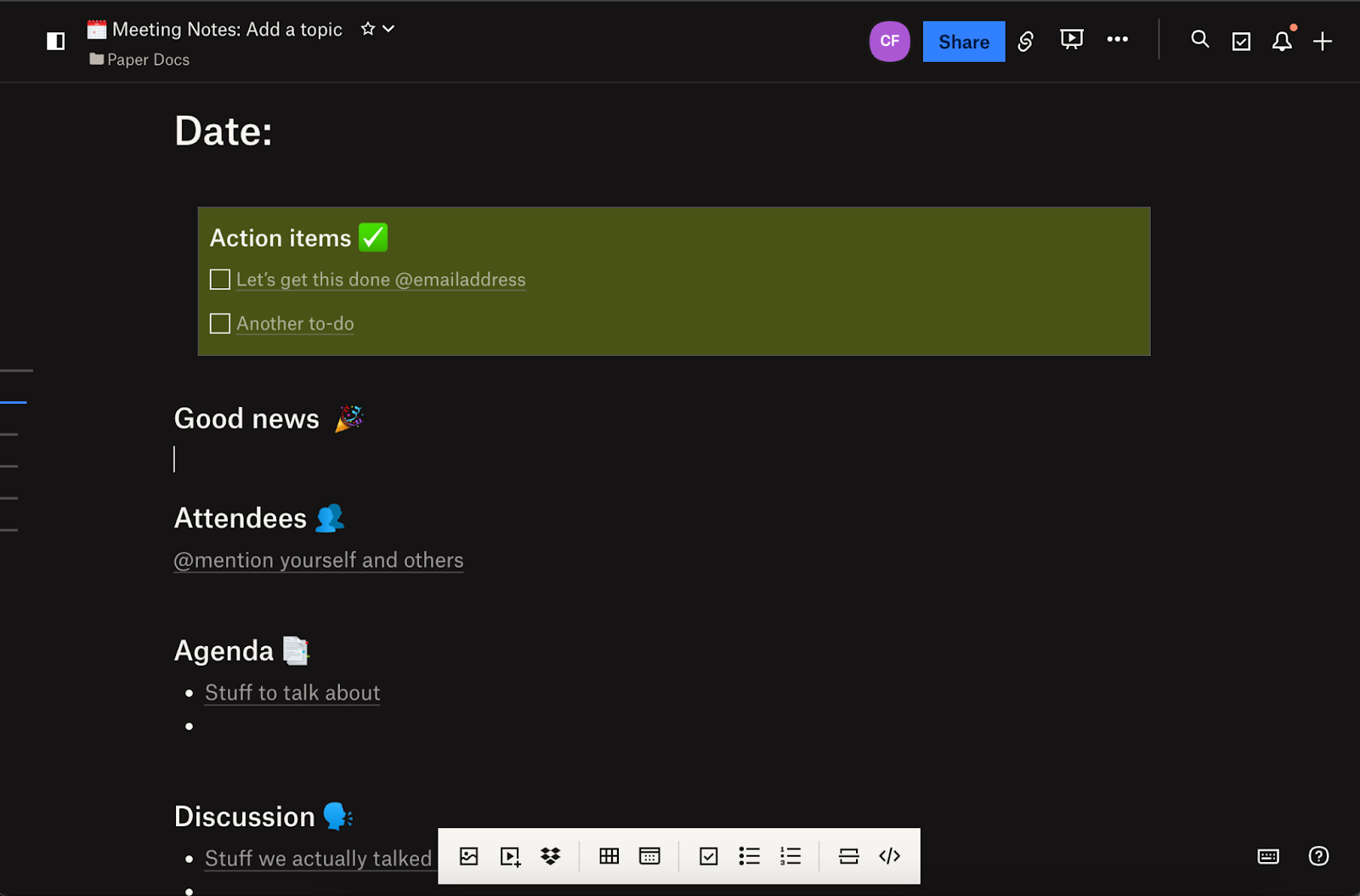

31. Brain warm-up
There comes a time in everyone's career when the mountains of work and stress start catching up on them, and every meeting feels like wading through mud. It’s what’s called the “zombie phase.” Your body is present in the meeting, but mentally, you’re not listening to a word anyone is saying.
To resurrect our team from zombie mode and inject some energy back into their spirit, we like to introduce a bit of friendly competition with a brain warm-up game.
In the past, we've kicked things off by randomly selecting a letter, setting a one- to two-minute timer, and challenging everyone to jot down as many words as they can that start with that letter. When we call "time," we tally up the results, and the person with the most words is crowned the winner.
Want to make it trickier? Customize your challenges.

For example, we recently played a game with our team where we gave our team a blank Team Charter Worksheet, put on a 5-minute timer, and then asked them to fill in as much of the charter as they could remember.
We have a step-by-step guide on how to create a team charter and a copy of the worksheet above. So, if you haven’t already got a team charter, why not make this into a team-building activity and then use it again a month or two later as an icebreaker?
32. Ps and Ns
The best icebreaker activities are the ones that peel back the layers we usually keep tucked away—the messy, human parts of ourselves. They remind us that nobody is superhuman and that every team member has struggles and stresses. Most importantly, they show us we've got each other's backs.
That’s exactly what Ps and Ns is great for. Here’s how it works: You ask your team to rate their mood from “P” (positive) to “N” (negative) and score their energy level from 1 (lethargic) to 5 (wired).
You can ask your teammates to explain why they’re feeling a certain way, or just keep it at the rating. Either way, this icebreaker gives you a good read on your team’s energy and reminds everyone that it’s okay to be real—you don’t have to pretend to be perfect to fit in or contribute.
.png)
33. I appreciate you
Give your team the chance to spread the love by hosting a short “compliment session” where everyone takes turns expressing gratitude for one of their teammates or pointing out something they’ve done recently that impressed them.
The great thing about this icebreaker is that you can use it in your async chats, not just in your meetings. For example, we encourage our team to send a virtual card to celebrate someone after they’ve helped them with a work task.
These gestures may seem small, but they pay off in a big way by creating a culture where feeling seen is prioritized and the little (but meaningful) actions don’t go unnoticed.
34. Meet my…
Sometimes, we like to keep things relaxed with an open-ended prompt that lets our team have fun interpreting it in their own way.
One of our favorite activities is the “Meet my…” game. We ask each team member to introduce us to something new. They can go the literal route, like sharing a photo of their pet in the group chat with the caption, “Meet my dog, Oliver.”
Or they can get creative and use tools, like AI-image generator Midjourney, to introduce us to their “alien best friend from the future.”
35. Deskercise roulette
In our “Meet and Move” pilot, we discovered that turning more casual 1:1’s into walking meetings helped boost our team’s energy levels, decreasing Zoom fatigue and increasing creativity and focus.
You can easily turn your icebreaker into a “sweat-breaker” by hosting a short “deskercise” training session. There are plenty of great deskercises, so feel free to mix it up each week with different activities—try strength one week and cardio the next.
For example, copy the 4-minute strength desk-out we used when we hosted one of our all-hands meetings.
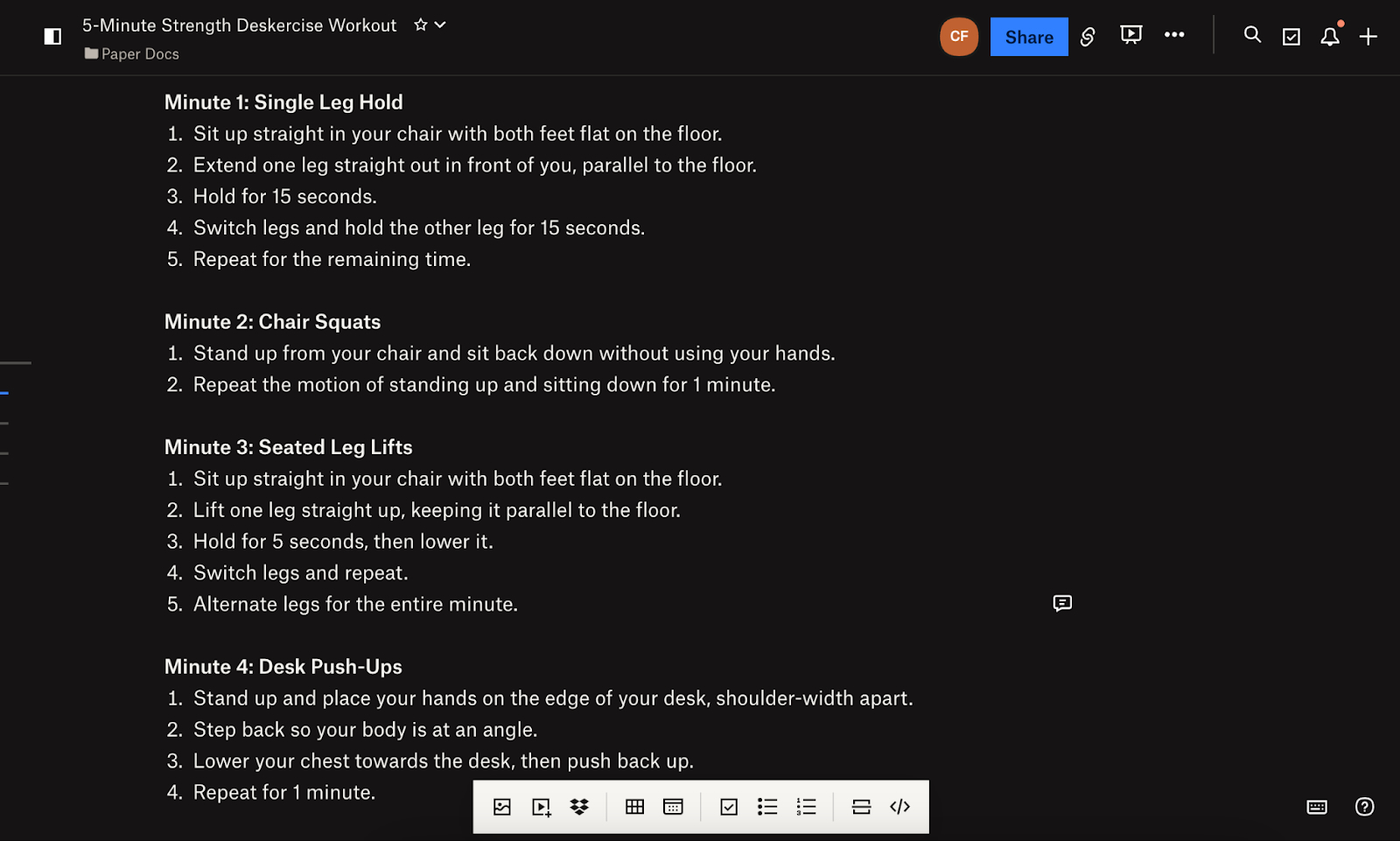
This keeps things fresh and gets people involved in new ways. To make sure everyone stays engaged and included, include exercises that can be done sitting or standing. That way, nobody will feel left out.
Find the best icebreakers for your virtual meetings
The great thing about icebreakers is that there are so many ways to keep your approach fresh. While a simple “How was your weekend?” can get the conversation flowing, you can also try creative ideas, like using virtual tarot cards or engaging in activities to strengthen meaningful connections.
Now that you have a few ideas to get you started, the next step is integrating these team activities into your team culture and regular meeting routines.
To find other ways Dropbox helps teams work together and improves productivity across the employee lifecycle, head over to our HR solutions page.
